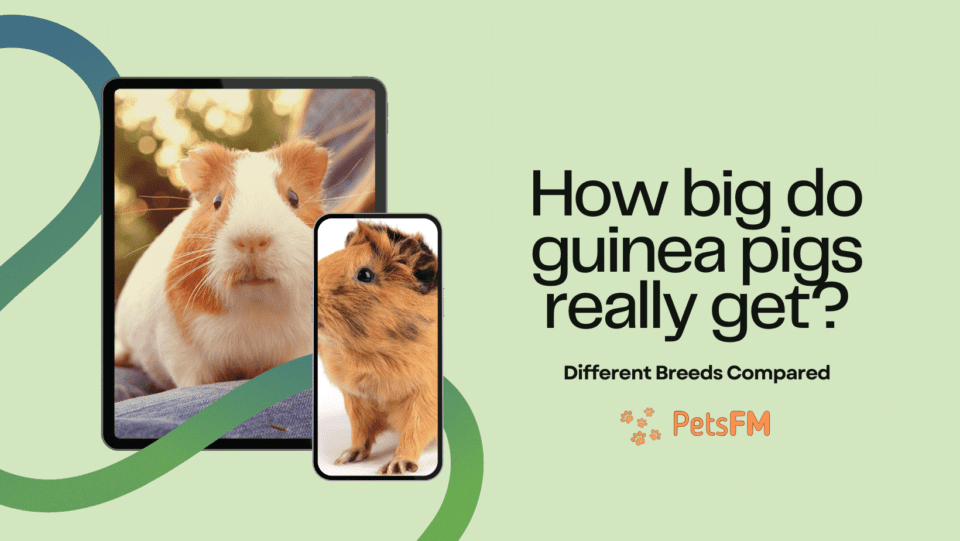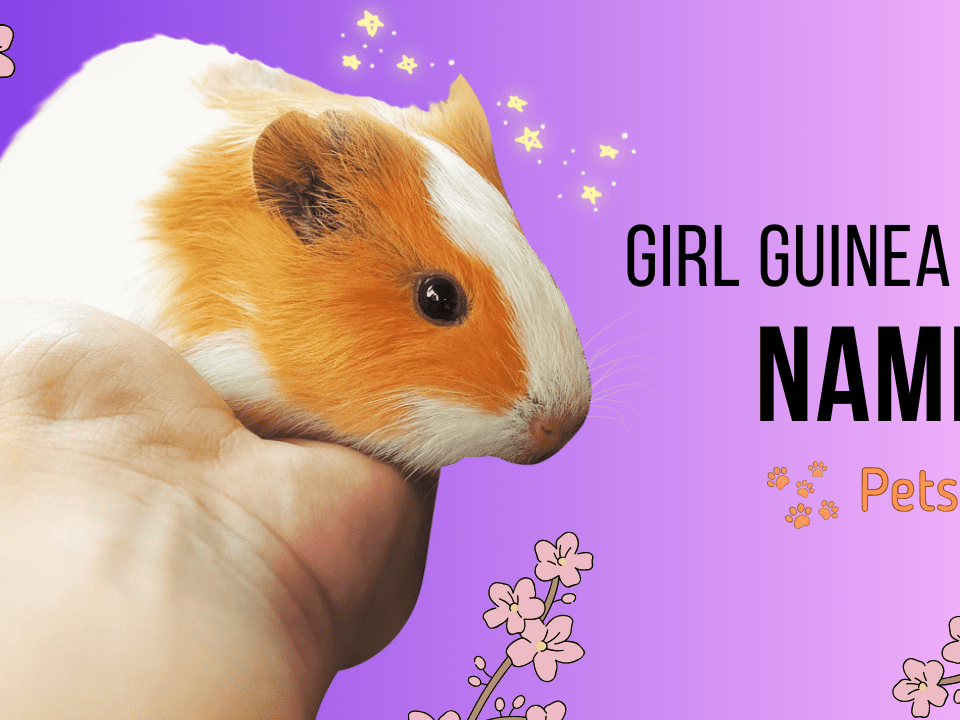


Are King Snakes Good Pets for Beginners?
February 29, 2024


Can Cats Kill Snakes? (Venomous & Non-Venomous Snakes)
March 5, 2024Welcome to the wonderful world of guinea pigs! These small, cuddly pets are loved by many for their friendly nature and playful personalities. Guinea pigs are perfect companions for people of all ages. They are not only cute but also have their own unique quirks and sounds, making them very special.
People worldwide choose guinea pigs as pets because they are gentle and easy to care for. If you’re looking for a pet that will bring joy and friendship to your home, a guinea pig might be a perfect choice. But you should learn a few considerations, such as its size, before getting a pet pig. Let’s dive in and learn more about these adorable creatures!
How big do guinea pigs typically get?
On average, adult guinea pigs reach 8 to 10 inches from the tip of their nose to the tip of their back. Regarding weight, a healthy adult guinea pig usually tips the scales at about 1.5 to 2.5 pounds. However, just like people, guinea pigs come in different shapes and sizes.
Some breeds are smaller or larger. For example, the tiny American guinea pig is often on the smaller side, while the fluffy Peruvian can be a bit longer because of its luxurious coat. No matter the breed, each guinea pig has its own unique charm!
What factors influence the size of a guinea pig?
Several important factors play a role in determining the size of a guinea pig, impacting its growth and overall health. Understanding these can help ensure your furry friend lives a happy and healthy life.
Genetics: Like humans, a guinea pig’s genes have a big say in size. The breed of the guinea pig can influence its overall length, with some species naturally larger or smaller than others. The size of a guinea pig’s parents can also give you a clue about how big it might get.
Diet: A nutritious diet is key to a guinea pig’s growth and size. Guinea pigs need a balanced diet rich in vitamin C, fiber, and other nutrients. This includes fresh hay, quality pellets, and a variety of fruits and vegetables. A well-fed guinea pig is more likely to reach its full-size potential and maintain a healthy weight.
Living Conditions: A guinea pig’s space can also affect its size and health. A spacious, clean habitat allows for more exercise, essential for preventing obesity and promoting healthy growth. Stressful or cramped living conditions can lead to health issues that might stunt a guinea pig’s growth or lead to weight problems.
Different breed sizes of guinea pigs
Guinea pigs come in a variety of breeds, each with its own unique characteristics, including size.
Here’s a look at some of the species and how their sizes can differ:
1: American Guinea Pig
- Size: Generally smaller, around 8-9 inches in length.
- Characteristics: Short, smooth coat. They are known for their docile nature and are famous for pet owners.
2: Peruvian Guinea Pig
- Size: Can be larger, reaching lengths of up to 10-12 inches due to their long fur.
- Characteristics: Has a long, silky coat that requires regular grooming. They are known for their striking appearance.
3: Abyssinian Guinea Pig
- Size: Similar to the American, but can sometimes grow slightly larger, around 8-10 inches.
- Characteristics: Features a unique coat with rosettes (swirls of fur) all over their body. They are known for their playful and energetic temperament.
4: Teddy Guinea Pig
- Size: Typically ranges from 8-10 inches, similar to the American breed.
- Characteristics: Has a dense, plush coat that resembles a teddy bear. They are known for being very friendly and affectionate.
5: Silkie Guinea Pig
- Size: They can grow to be about 10-14 inches long on the larger side.
- Characteristics: Known for their long, flowing coat that grows backward over their body. They require a lot of grooming and are known for their calm demeanor.
| Breed | Average Weight (lbs) |
| American | 1.5 – 2.5 |
| Peruvian | 1.5 – 2.5 |
| Abyssinian | 1.5 – 2.5 |
| Teddy | 1.5 – 2.5 |
| Silkie | 1.5 – 2.5 |
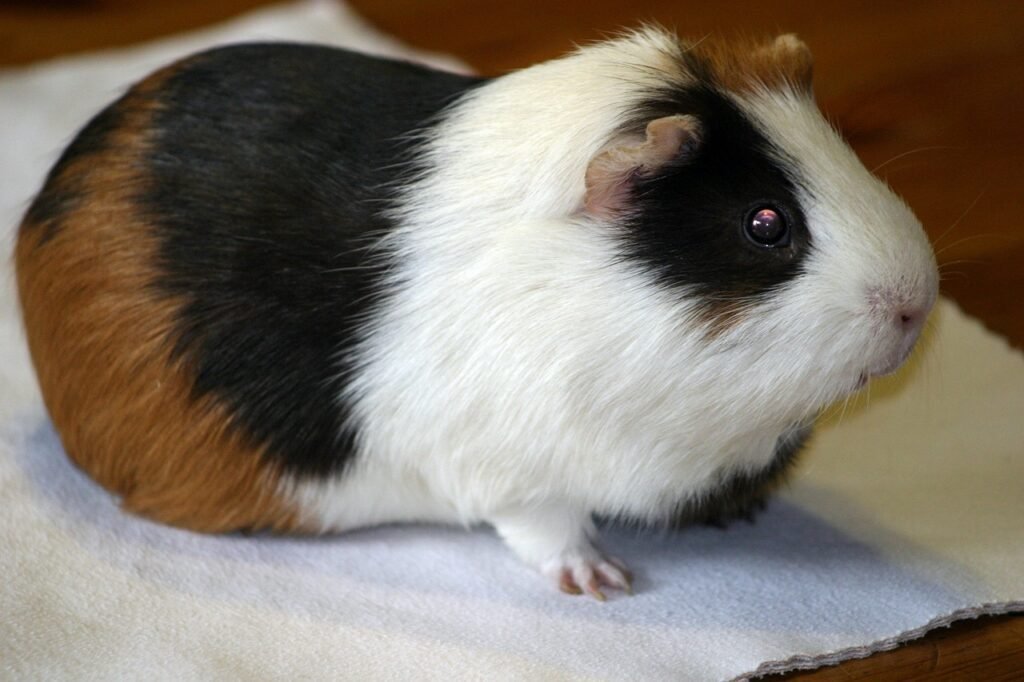

Guinea Pig
What is the average size of a male guinea pig?
The average size of a male guinea pig, also known as a boar, typically ranges from 8 to 10 inches in length and can weigh anywhere from 2 to 2.6 pounds. Male guinea pigs are often slightly larger and heavier than their female counterparts.
What is the average size of a female guinea pig?
Female guinea pigs, known as sows, usually measure about 8 to 10 inches in length, but they tend to be lighter, weighing in at 1.5 to 2.5 pounds. The size can vary based on diet, genetics, and overall health.
What is the average size of a baby guinea pig?
A baby guinea pig, or pup, is much smaller at birth, weighing around 2.5 to 3.5 ounces and measuring 3 to 4 inches in length. They grow quickly, reaching near adult size at about 8 weeks old.
How can you tell if your guinea pig is overweight?
Telling if your guinea pig is overweight involves observing its overall shape and behavior. Here are some tips to help you determine if your pet might be carrying extra weight:
- Body Shape: A healthy guinea pig should have a pear-shaped body when viewed from above, with a slight taper from the hips to the head. If your guinea pig’s body appears round or oval, with no discernible waist, it may be overweight.
- Ribs Check: Gently feel your guinea pig’s ribs. You should be able to feel them with a slight layer of fat over them. Your guinea pig might be overweight if you cannot feel the ribs at all.
- Difficulty Moving: Watch how your guinea pig moves. If it seems to struggle with activities it once found easy, like running or climbing, it could be a sign that excess weight hinders mobility.
- Chin and Neck Area: Check for excess fat deposits around the chin and neck. Overweight guinea pigs may develop a double chin or have fat folds in these areas.
- Eating Habits: Overeating, especially high-calorie foods or too many treats, can lead to weight gain. Ensure your guinea pig has a balanced diet consisting mainly of hay, fresh vegetables, and a limited amount of pellets and fruits.
How can you measure your guinea pig?
Measuring your guinea pig involves taking its length and weight to monitor its growth and health. Here’s how you can do it safely:
Measuring Length:
- Prepare a Soft Measuring Tape: Use a flexible, soft measuring tape, as it’s gentle on your guinea pig and easy to wrap around its body if needed.
- Gently Hold Your Guinea Pig: Place your guinea pig on a flat, secure surface. You might need someone to help keep your guinea pig calm and still.
- Measure From Nose to Rear: Stretch the measuring tape from the tip of your guinea pig’s nose to the end of its rear (excluding the tail, as guinea pigs have very short tails). Do this gently without causing any discomfort to your pet.
Weighing Your Guinea Pig:
- Use a Small Scale: A kitchen or small pet scale works well. Make sure it has a flat surface and can be measured in grams or ounces, as this is more accurate for small animals.
- Place a Container on the Scale: To help keep your guinea pig still, place a container or bowl on the scale. Zero the scale with the container to ensure the measured weight is just your guinea pig’s.
- Gently Place Your Guinea Pig in the Container: Carefully put your guinea pig in the container and wait for it to settle down so you can get a stable reading. Record the weight.
Tips for Accurate Measurement:
- Measure Regularly: Regular measurements can help you track your guinea pig’s growth over time and notice any sudden changes in size or weight.
- Keep Records: Write down each measurement to monitor your guinea pig’s development or identify any health concerns early.
- Ensure Comfort: Always handle your guinea pig gently to avoid stress or injury during the measuring process.
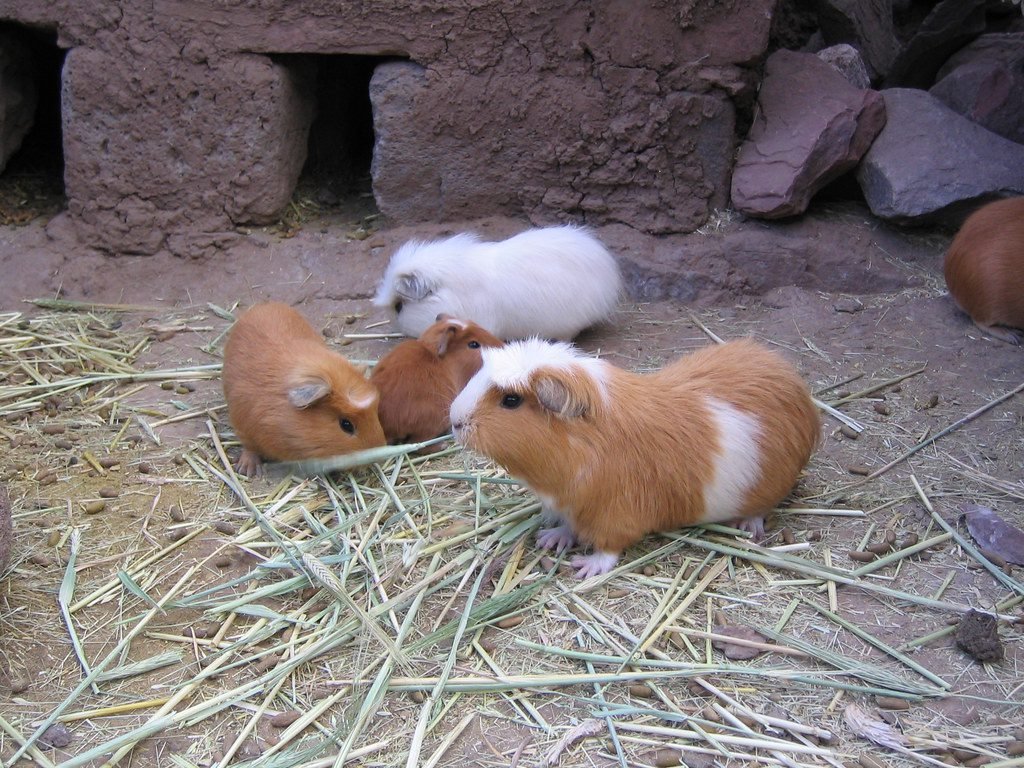

Multiple Guinea Pigs
How can you maintain your guinea pig’s weight?
Maintaining your guinea pig’s weight is crucial for overall health and longevity. Here are some strategies to help keep your guinea pig at a healthy weight:
1: Offer a Balanced Diet
- Hay: Make sure fresh hay is always available, as it’s essential for digestive health and dental wear.
- Pellets: Provide a measured amount of high-quality guinea pig pellets daily. Avoid overfeeding pellets, as they are calorie-dense.
- Fresh Vegetables: Introduce a variety of fresh vegetables, especially leafy greens, to provide essential vitamins and minerals. Limit starchy vegetables and fruits due to their high sugar content.
2: Limit Treats
Treats should be given sparingly. Choose healthy options like small pieces of fruit or special guinea pig treats, but remember that these should not exceed 10% of their diet.
3: Ensure Regular Exercise
- Free Roam Time: Allow your guinea pig out of its cage for supervised exploration or play in a guinea pig-proofed room for at least an hour daily.
- Interactive Toys: Provide toys that encourage movement, such as tunnels or balls, to keep your guinea pig active.
4: Monitor Weight Regularly
Weigh your guinea pig weekly to track its weight. Sudden weight gain or loss can indicate health issues needing veterinary attention.
5: Provide a Spacious Cage
A larger cage allows for more movement and exercise. Ensure the cage has enough room for the guinea pig to run and play.
6: Implement a Feeding Schedule
Stick to a consistent feeding schedule. This helps prevent overeating and ensures your guinea pig eats its food gradually throughout the day.
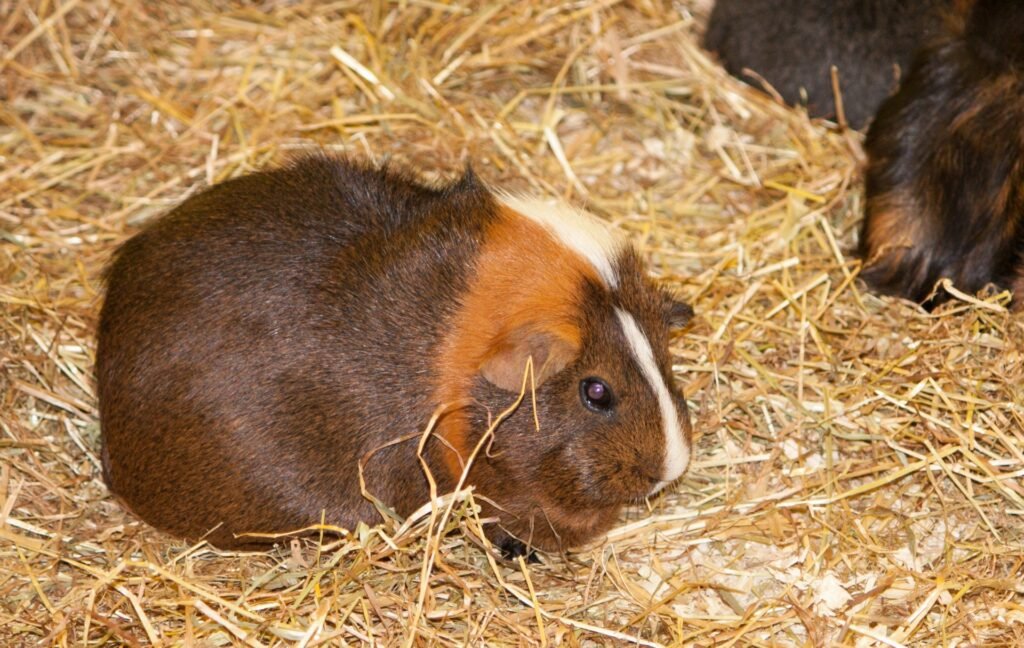

What should you do if your guinea pig is losing weight?
If your guinea pig is losing weight, it’s essential to take immediate action to determine the cause and address it. Weight loss in guinea pigs can be a sign of illness or improper diet. Here’s what you can do:
1: Check the Diet
- Ensure Adequate Nutrition: Ensure your guinea pig receives a balanced diet consisting of unlimited hay, high-quality guinea pig pellets, and fresh vegetables. Lack of vitamin C can lead to weight loss, so consider a vitamin C supplement if your guinea pig’s diet may be deficient.
- Monitor Food Intake: Observe if your guinea pig eats less than usual. Dental problems can make eating painful, leading to decreased food intake.
2: Observe for Other Symptoms
Look for signs of illness, such as changes in behavior, diarrhea, lethargy, or difficulty breathing. Weight loss accompanied by these symptoms requires immediate veterinary attention.
3: Veterinary Check-Up
- Schedule a Vet Visit: A veterinarian can assess your guinea pig’s health, perform necessary tests to diagnose the issue and provide treatment. This may include blood tests, dental checks, and X-rays.
- Discuss Diet Adjustments: The vet may suggest dietary changes or supplements to help your guinea pig regain weight.
4: Monitor Weight Regularly
Weigh your guinea pig weekly to track its weight. This will help you notice any slight changes in weight over time, allowing for early intervention if weight loss continues.
5: Ensure a Comfortable Environment
Stress can contribute to weight loss. Make sure your guinea pig’s living environment is comfortable, safe, and free from stressors. This includes maintaining proper temperature, hiding places, and ensuring a quiet, peaceful location.
6: Encourage Eating
Offer favorite foods and fresh, leafy greens to stimulate appetite. You can also try hand-feeding if your guinea pig refuses to eat alone.
7: Hydration
Ensure your guinea pig has access to fresh, clean water. Dehydration can accompany weight loss and exacerbate health problems.
Conclusion
Maintaining your guinea pig’s health through proper diet, exercise, and regular veterinary check-ups is crucial for their wellbeing. If you notice weight loss or other signs of illness, act promptly to address these issues. By providing loving, attentive care, you can ensure a happy, healthy life for your guinea pig.
